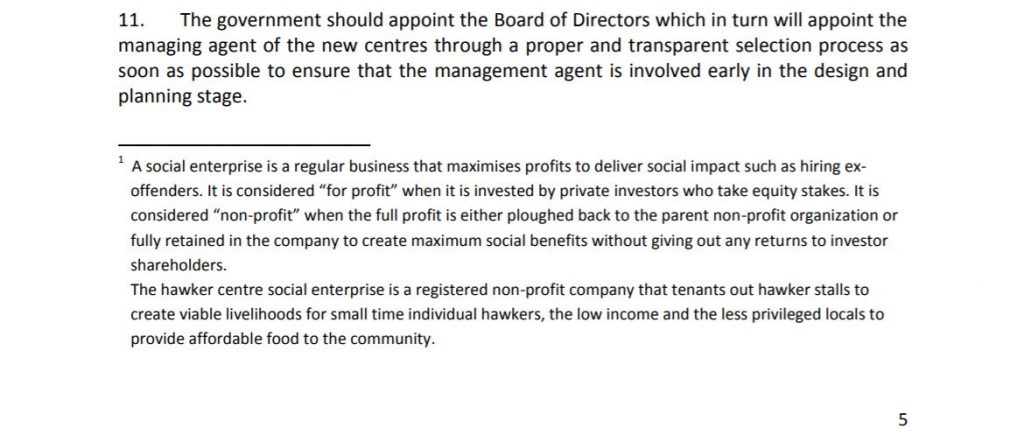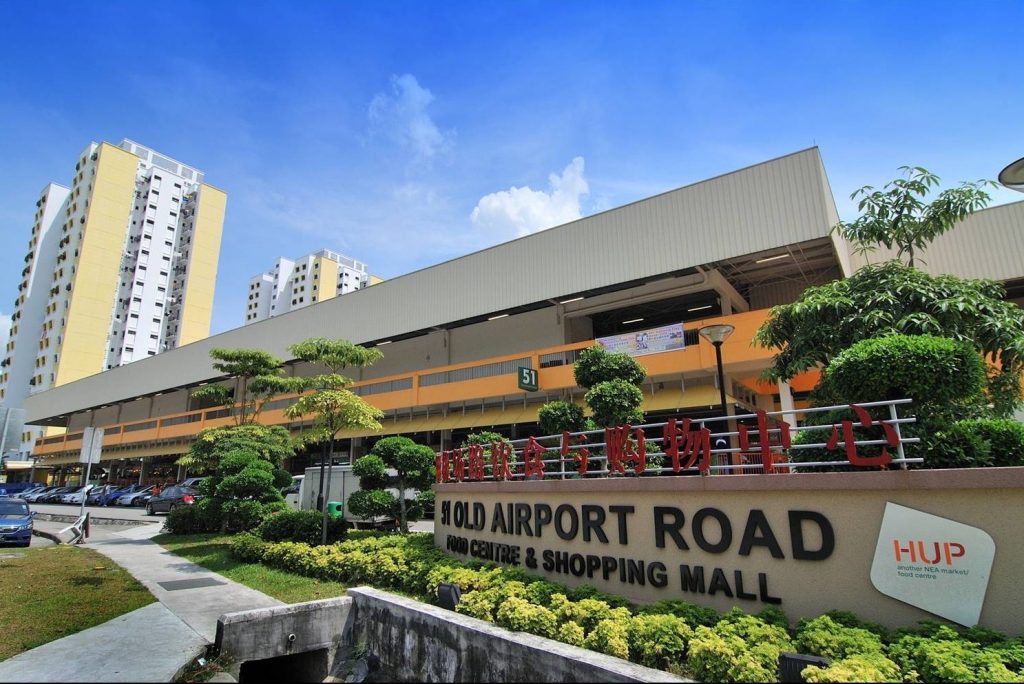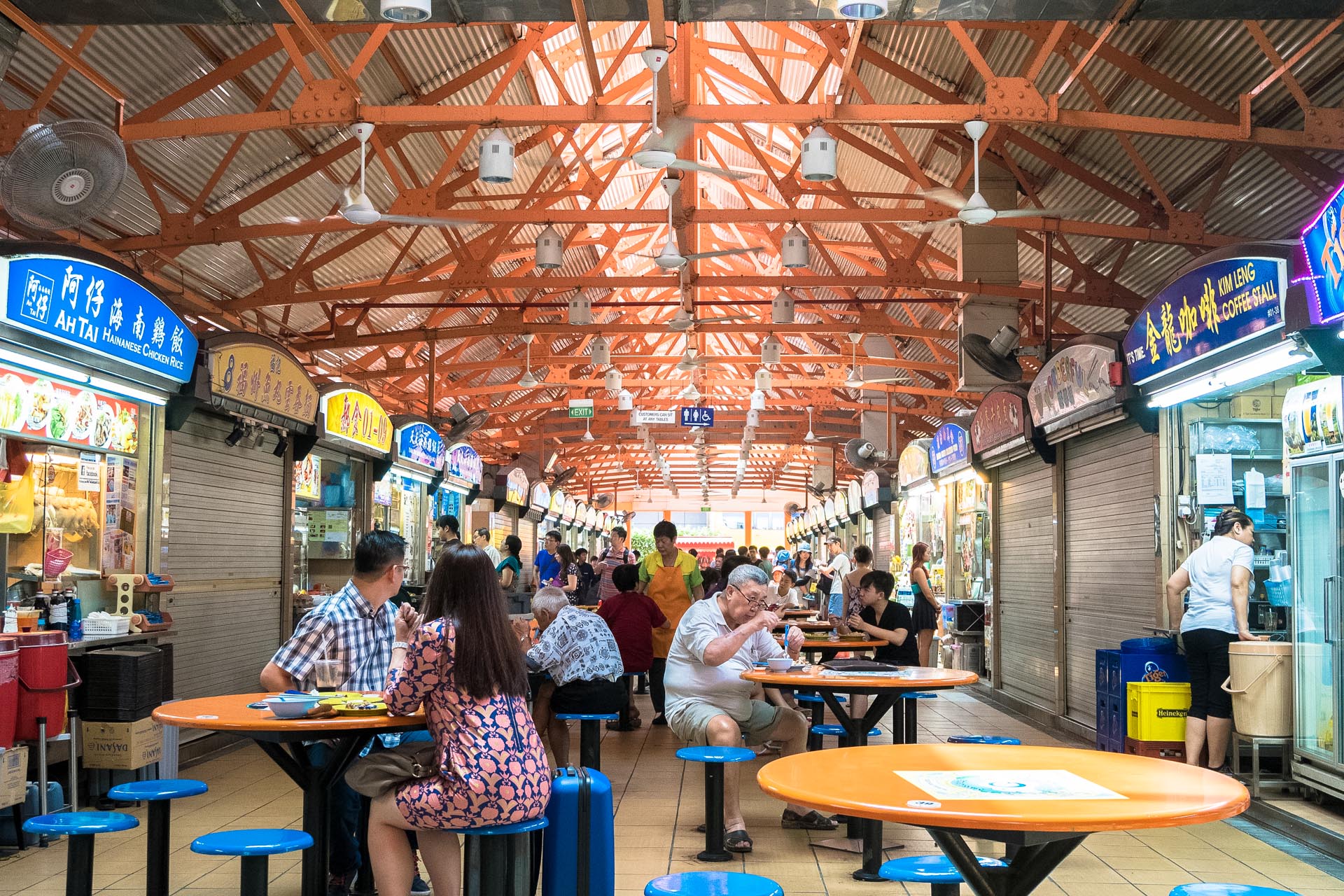In 2011, an 18-member Hawker Centres Public Consultation Panel was formed to ‘provide ideas for the hawker centres of the future’. The panel — chaired by 77th Street’s Ms. Elim Chew and comprising of representatives from architecture, F&B, social enterprises and yes, NTUC itself — spent approximately 5 months (Nov to March) studying the issue before making its report to the relevant Ministry in 2012.
In its final recommendation, the panel proposed ‘social enterprises’ as the answer. By adopting a not-for-profit social enterprise management model, these yet-hypothetical SEHCs could:
2.Serve as an employment opportunity for less-privileged
3.Provide a platform for aspiring hawkers
Aside from its primary objectives, there were also lofty goals that ranged from sensible (‘saving water’) to ambitious (a ‘crucible’ and repository of diverse food heritage) to the insane (‘pulsating with energy and activity’). Everything from vibrancy to social graciousness was highlighted, but ultimately, the plan depended on a ‘dedicated management team’ to realise these goals.
Hence, social enterprises—born of the assumption that NEA and/or independent hawkers needed a shepherd to guide them into the brave new future.

The answer, I think, lies in the footnotes of 2011’s report, which gives us the clearest definition of a social enterprises hawker centre:

However, the profit stays in the parent organisation (i.e. NTUC Foodfare or Kopitiam) or is re-invested in ‘social benefits’ like ‘affordable options’ or ‘incubation stalls for aspiring hawkers’.
That’s why Seetoh’s accusation of hardcore ‘food-court-style’ profiteering are not exactly unwarranted. Unlike an NEA hawker centre which does not serve a bottom line, the new SEHCs must make a profit in order to achieve its goals. It has to operate like a food court because it needs actual profits before said profits can be ‘ploughed back’ into any kind of social impact.
No profits. No social impact.
Or as my colleague Grace Yeoh writes: ‘a social enterprise is first and foremost a regular business.’
This naturally causes tension. After all, the resources for creating the ‘hawker centre of the future’ has to come from somewhere. Should the ‘dedicated management team’s management practices fail to increase revenue, the cost of delivering the ‘social’ part of a SEHC would be borne by either the operator or, as some parties have alleged, the hawkers themselves.
Those profits might be going to a good cause, but that’s cold comfort for the individual hawkers, who are essentially forced to subsidise ‘vibrancy’, ‘affordability’, ‘environmental sustainability’ and other objectives which do not benefit them one bit.
For them, working under a social enterprise might not feel any different from privatisation, because—to the best of our knowledge—it is privatisation in all but name.

I have nothing against the profit motive or the private sector. Running the hawker centre as a private enterprise has its own merits, chief among them a reduced need for massive government subsidies, like the $420 million we recently spent on renovation alone.
Theoretically at least, a corporate management structure would make the hawker centre self-sustainable, more responsive to changing market forces, and free to pursue larger goals—be they social or commercial.
Unfortunately, it would also kill off hawker culture entirely.
A hawker centre with a centralised management which dictates opening hours, leave, and menu options, who selects its tenants based on a set criteria rather than a laissez-fairez tender system, is not a hawker centre.
It is a food court without air-conditioning.
This is because Hawker Centres are defined not only by the type of food served or the open-air environment but also the independence of its hawkers, who are business owners in their own right and accountable to no higher power other than themselves.
They work their own hours, cook whatever way they see fit, and operate the business according to their own standards and principles, with no regard for government policies like ‘affordability’ or ‘health’. This fundamental liberty, inherited from the days of unregulated street hawkers, is what turns hawker centres into ‘hawker culture’.
But when you remove this independence and place them under a corporate management team with all the manifold powers of a food court operator, then it ceases to be a Hawker Centre.
When you impose a social mandate like ‘serving the community’ or ‘affordability’, it likewise threatens the independence which underpins a vibrant hawker culture.
Because what makes a hawker centre unique and worth preserving is the lack of authority leading to haphazard variety. When you walk into a hawker centre, you are likely to find: 3 fish soup uncles with 3 different takes on the dish, 2 warring chicken rice stalls next to each other, 7 different service standards ranging from intimate to rude, one hipster hawker next to a 18-year-old Laksa dynasty, 19 different types of chilli sauce and 23 different types of signage—inducing suicidal thoughts in any branding consultant.
This organic chaos— the last and tenuous connection to street-peddling—is anathema to any profit-maximising private enterprise. It cannot co-exist with a centralised management who chooses its tenants and runs the place to pursue its own singular set of KPIs.
In short, the social enterprise hawker centre is an oxymoron. You can either have a social enterprise food court or you can have hawker culture. You cannot have both. Trying to combine the best of both worlds will produce — at best — a sort of Hawker Culture Disneyland with only the appearance of diversity and vibrancy — like the faux-retro kopitiam aesthetic in an MBS basement.
So if social enterprises is the future awaiting all hawker centres, then let’s not make a fool of ourselves by nominating it for UNESCO status. It would be as ridiculous as nominating NTUC Foodfare or Koufu.








